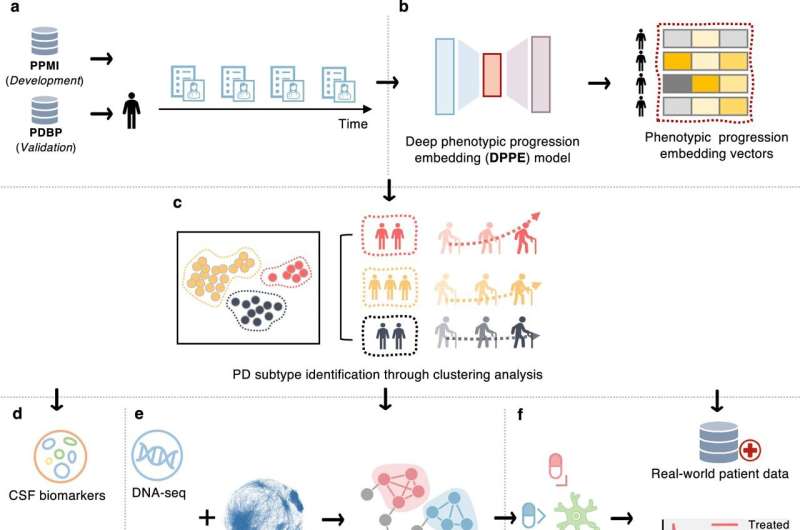This article has been reviewed according to Science X's editorial process and policies. Editors have highlighted the following attributes while ensuring the content's credibility:
fact-checked
peer-reviewed publication
trusted source
proofread
Machine learning helps define new subtypes of Parkinson's disease

Researchers at Weill Cornell Medicine have used machine learning to define three subtypes of Parkinson's disease based on the pace at which the disease progresses. In addition to having the potential to become an important diagnostic and prognostic tool, these subtypes are marked by distinct driver genes. If validated, these markers could also suggest ways the subtypes can be targeted with new and existing drugs.
The research was published on July 9 in npj Digital Medicine.
"Parkinson's disease is highly heterogeneous, which means that people with the same disease can have very different symptoms," said senior author Dr. Fei Wang, a professor of population health sciences and the founding director of the Institute of AI for Digital Health (AIDH) in the Department of Population Health Sciences at Weill Cornell Medicine. "This indicates there is not likely to be a one-size-fits-all approach to treating it. We may need to consider customized treatment strategies based on a patient's disease subtype."
The investigators defined the subtypes based on their distinct patterns of disease progression. They named them the Inching Pace subtype (PD-I, about 36% of patients) for disease with a mild baseline severity and mild progression speed; the Moderate Pace subtype (PD-M, about 51% of patients) for cases that have mild baseline severity but advance at a moderate rate; and Rapid Pace subtype (PD-R), for cases with the most rapid symptom progression rate.
They were able to identify the subtypes by using deep learning-based approaches to analyze deidentified clinical records from two large databases. They also explored the molecular mechanism associated with each subtype through the analysis of patient genetic and transcriptomic profiles with network-based methods. For example, the PD-R subtype had activation of specific pathways, such as those related to neuroinflammation, oxidative stress and metabolism. The team also found distinct brain imaging and cerebrospinal fluid biomarkers for the three subtypes.
Dr. Wang's lab has been studying Parkinson's since 2016, when the group participated in the Parkinson's Progression Markers Initiative (PPMI) data challenge; the team won the challenge on the topic of deriving subtypes, and since then has continued this work. They employed the data collected from the PPMI cohort as the primary subtype development cohort in their research and validated it with National Institute of Neurological Disorders and Stroke (NINDS) Parkinson's Disease Biomarkers Program (PDBP) cohort.
The researchers used their findings to identify possible drug candidates that could be repurposed to target the specific molecular changes seen in the different subtypes. They then used two large-scale, real-world databases of patient health records to confirm these drugs could help ameliorate Parkinson's progression.
These databases, the INSIGHT Clinical Research Network, based in New York, and the OneFlorida+ Clinical Research Consortium, are both part of the National Patient-Centered Clinical Research Network (PCORnet). INSIGHT is led by Dr. Rainu Kaushal, senior associate dean for clinical research at Weill Cornell Medicine and chair of the Department of Population Health Sciences at Weill Cornell Medicine and NewYork-Presbyterian/Weill Cornell Medical Center.
"By examining these databases, we found that people taking the diabetes drug metformin appeared to have improved disease symptoms—especially symptoms related to cognition and falls—compared with those who did not take metformin," said first author Dr. Chang Su, an assistant professor of population health sciences and also a member of the AIDH at Weill Cornell Medicine. This was especially true in those with the PD-R subtype, who are most likely to have cognitive deficits early in the course of their Parkinson's disease.
"We hope our research will lead other investigators to think about using diverse data sources when conducting studies like ours," Dr. Wang said. "We also think that translational bioinformatics investigators will be able to further validate our findings, both computationally and experimentally."
A number of collaborators contributed to this work, including scientists at the Cleveland Clinic, Temple University, University of Florida, University of California at Irvine, and University of Texas at Arlington, as well as doctoral candidates from the computer science program at Cornell Tech and the computational biology program at Cornell University's Ithaca campus.
More information: Chang Su et al, Identification of Parkinson's disease PACE subtypes and repurposing treatments through integrative analyses of multimodal data, npj Digital Medicine (2024). DOI: 10.1038/s41746-024-01175-9





















